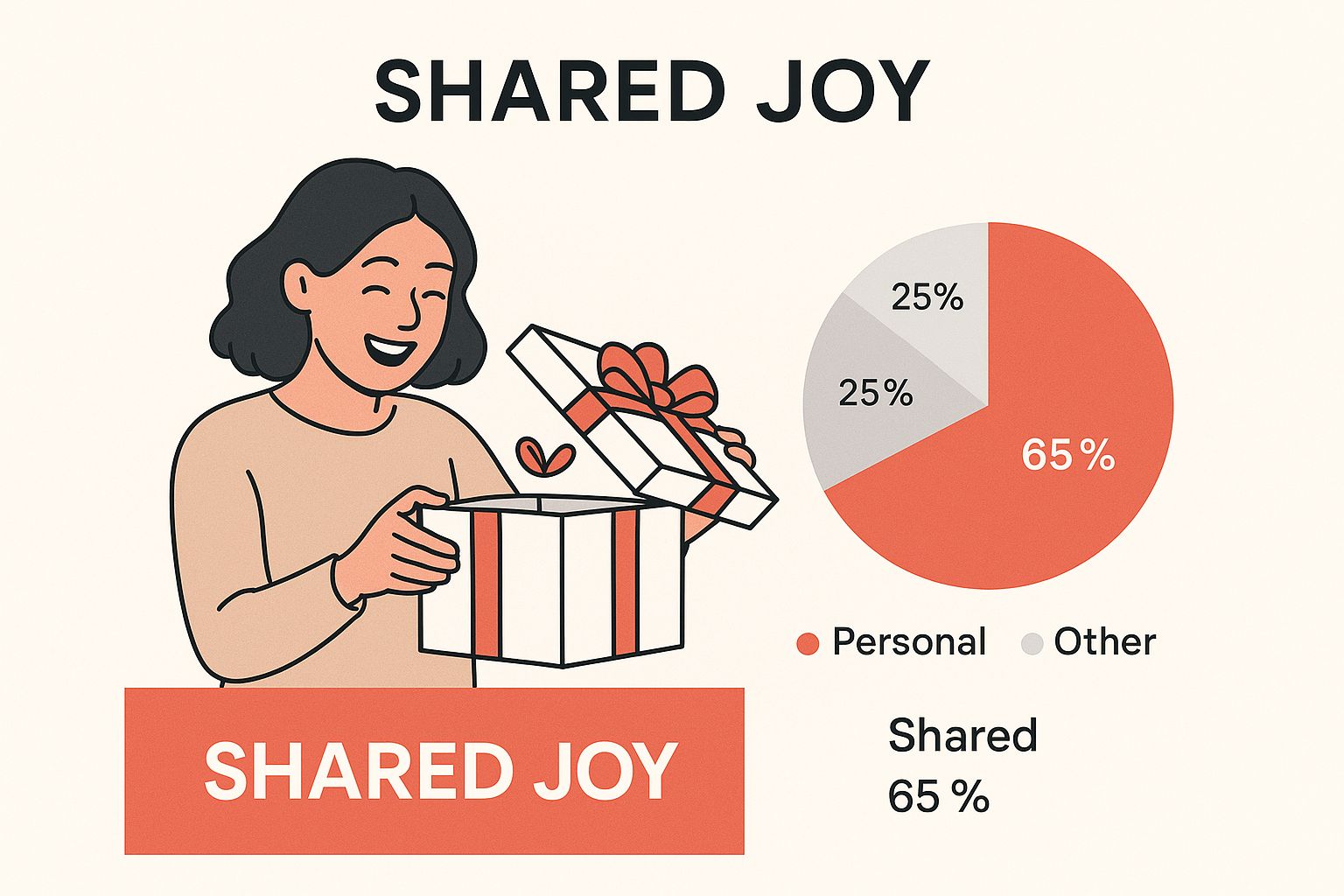The Hidden Science Behind Why We Give Gifts

Early humans traded gifts to ensure survival. Sharing food or tools kept communities fed and safe. These simple exchanges laid the foundation for the social customs we practice today.
Evolutionary Origins Of Gift Giving
Anthropologists identify three core survival strategies behind gift giving:
- Resource Sharing: Dividing scarce food prevented starvation and kept the group healthy.
- Alliance Building: Gifts of tools or game reinforced loyalty and warded off rivals.
- Mating Displays: Valuable offerings signaled someone’s ability to provide for a family.
Over time, these survival tactics grew into rituals that cross cultures. But when resources are ample, what drives us to keep giving? Psychology has the answer.
Reciprocity And Social Bonds
One of the strongest influences is reciprocity, where people feel compelled to return kindness. This principle appears across societies, shaped by both emotion and culture. A 2019 study found that spending money on others boosts happiness for the giver, no matter the recipient’s response. Read the full research here
That emotional payoff doesn’t just feel good—it builds trust and mutual obligation, strengthening social ties.
Key Benefits Of Gift Giving
| Benefit | Description |
|---|---|
| Emotional Fulfillment | Both givers and receivers report a “warm glow” after an exchange. |
| Strengthened Trust | Regular gifts signal reliability and predictability in relationships. |
| Social Cohesion | Shared gift rituals reinforce cultural values and group identity. |
Even small tokens can carry major meaning. Gifts tap into deep needs for care, status, and belonging.
Small Gestures, Big Impact
Tiny presents—a handwritten note or a homemade snack—can trigger the same positive response as an elaborate gift. One person received a family recipe in calligraphy plus an offer to cook together, creating a memory richer than any store-bought item.
Tips for selecting meaningful gifts:
- Listen Closely: Note casual mentions of interests or upcoming needs.
- Prioritize Experience: Choose items that lead to shared adventures.
- Personalize Thoughtfully: Add a favorite color or inside joke to make it special.
Understanding the psychology of gift giving helps you create presents that resonate long after the ribbon is gone.
The Joy Circuit: What Happens In Your Brain When You Give
Choosing the perfect gift does more than bring smiles—it lights up the helper’s high in your brain’s reward centers. When you hunt for that ideal present, regions tied to joy and connection also spring into action. No wonder giving can feel just as rewarding as receiving.
Mapping The Neural Pathways
Scientists rely on fMRI scans to trace the precise neural pathways triggered by gift giving. These images reveal that both the ventral striatum and prefrontal cortex glow with activity, marking anticipation of reward and thoughtful decision-making.
Here’s a look at the key brain chemicals released and how they shape our mood during gift giving:
Brain Chemicals Activated During Gift Giving
This table shows the key neurotransmitters and hormones released during gift giving and their effects on mood and behavior
| Brain Chemical | Primary Function | Effect During Gift Giving |
|---|---|---|
| Oxytocin | Social bonding | Increases trust and empathy |
| Dopamine | Reward signaling | Reinforces generosity through pleasurable feedback |
| Endorphins | Pain and stress regulation | Creates a calm, euphoric feeling |
| Serotonin | Mood modulation | Enhances overall sense of well-being |
Each of these chemicals plays a unique role in wiring kindness into our biology, making every act of giving feel deeply satisfying.
The Role Of Oxytocin In Bonding
Often called the “love hormone,” oxytocin surges when you watch someone unwrap your present. It strengthens emotional ties, transforming a simple exchange into a lasting memory.
- Boosts social trust
- Lowers stress levels
- Fuels lasting connection
Dopamine: The Generosity Addiction
At the same time, dopamine floods your system, creating a cycle of generosity that’s hard to resist. This neurotransmitter rewards kind intentions and nudges you toward giving again.
- Drives the thrill of anticipation
- Reinforces repeat generosity
- Builds “give-give” momentum
Societal And Economic Ripple Effects
Gift giving doesn’t stop at personal bonds—it influences communities and markets too. Generosity activates brain areas linked to pleasure, creating a warm glow that encourages more acts of kindness.
- Strengthens community ties
- Fuels retail spending during holidays
Discover more insights about these dynamics here.
The Gift-Giving Disconnect: What We Want vs. What We Give
Have you ever noticed someone handing over a fruit basket when most would prefer an Amazon gift card? That mismatch comes from gift-givers following tradition rather than recipient needs. Behavioral studies show even well-meaning shoppers mispredict favorites, guided by habit more than actual desire. A typical holiday fruit basket or generic bottle of wine might feel impersonal or out of touch.
Recognizing these patterns is the first step toward bridging the gap between thoughtfulness and usefulness in gift giving.
Projection Bias And Social Expectations
Projection Bias drives many of our gift choices, nudging us to buy items we’d enjoy ourselves—like boutique candles or novelty gadgets. Unspoken social rules push us toward elaborate wrapping and surprise reveals, as we fear appearing thoughtless.
- We overvalue the thrill of novelty, assuming surprise outperforms practicality.
- We avoid cash gifts, seeing them as impersonal or lazy.
- We default to “safe” physical items that miss actual needs.
This mix of projection and social pressure often sacrifices real usefulness for showmanship.
The Statistical Reality
A 2019 survey by Mint found that 61% of Americans prefer receiving cash or gift cards, yet only 19% are willing to give cash and 21% would offer gift cards. Moreover, 64% of respondents struggle to find the right gift.
Visualizing The Preference Gap
Below is a data chart that visualizes the difference between what recipients want and what givers choose. This bar chart highlights key trends and shows how popular gift types stack up against actual giving behaviors.

The chart reveals a 42% shortfall for cash gifts and a –15% oversupply of physical and homemade gifts. Experiences show the smallest gap (20%), suggesting they’re easier to match with recipient preferences.
The Gift Preference Gap
This table compares what people prefer to receive versus what they typically give as gifts across different categories
| Gift Type | Percentage Who Prefer to Receive | Percentage Willing to Give | Preference Gap |
|---|---|---|---|
| Cash | 61% | 19% | 42% |
| Gift Cards | 55% | 21% | 34% |
| Experiences | 50% | 30% | 20% |
| Physical Goods | 45% | 60% | –15% |
| Homemade Gifts | 20% | 35% | –15% |
In summary, cash and gift cards face the largest gaps, while physical and homemade gifts are often oversupplied. Considering experiences can help narrow the divide and deliver more satisfying gifts.
Cracking The Gift Code: The Art Of Meaningful Selection
Gift giving isn’t just about cost—it’s about the feelings it sparks. Studies in the psychology of gift giving reveal that thoughtful choices often outshine price tags. A 2020 survey showed experience-based presents deliver 25% more lasting satisfaction than material items. Opting for memories over merchandise can deepen connections and keep relationships lively.
Why Experiences Outshine Objects
Experiences build stories instead of cluttered closets.
- Emotional Impact: Shared adventures release oxytocin and reinforce bonds.
- Lasting Recall: 68% of people remember experiences five years later versus 45% for objects.
- Social Currency: Concerts, classes, and trips become tales that keep on giving.
| Feature | Experiences | Material Gifts |
|---|---|---|
| Memory Retention | 68% long-term recall | 45% long-term recall |
| Emotional Bonding | High (shared moments) | Medium (individual items) |
| Shelf Life | Permanent (stories endure) | Varies (may sit unused) |
These numbers show why event-based gifts can feel more meaningful than gadgets.
Reflecting Identity And Aspirations
Matching a gift to someone’s passions makes it memorable.
- Listen for hobbies, dreams or values mentioned in conversations.
- Choose gifts that align with personal ideals like sustainability or creativity.
- Showcase individuality with a custom design—such as an AI-created tee from ThisShirtExists.
This ensures your present reflects their goals, not your assumptions.
Avoiding The Presenter’s Paradox
Offering too many options can dilute excitement. Keep choices focused.
- Limit the selection to two or three well-curated items.
- Highlight one standout feature or story behind each option.
- Arrange options by increasing personal relevance to build anticipation.
A simple lineup prevents overwhelm and boosts perceived value.
Timing And Presentation Hacks
When you give matters almost as much as what you give.
- Pick a relaxed setting—weekend brunch or a quiet evening.
- Use themed wrapping or include a hint about the gift’s meaning.
- Add a handwritten note to reinforce the emotional message.
Main Takeaway: Gifts that combine emotional experiences, personal relevance, and thoughtful presentation become treasured memories.
Gift Psychology Across Cultures: What Every Giver Should Know

Across countries, the psychology of gift giving can shift dramatically. In one place, the thought behind a present might matter most; in another, the item itself could carry hidden meaning. For instance, Japanese recipients often treasure the unwrapping ritual more than the gift it reveals.
Gift Wrapping Rituals In Japan
In Japan, 90% of people say that beautiful packaging adds value to a present. Neatly folded paper, precise corners, and a perfectly tied bow show respect and care. Even a small token gains prestige through this effort, strengthening the connection between giver and receiver.
Timing And Taboos In China
Choosing when and what to give carries its own rules in China.
- Steer clear of the number 4—it sounds like “death” in Mandarin.
- Opt for even-numbered dates during festivals to support balance.
- Avoid clocks and umbrellas, which hint at farewells.
By following these customs, you help the recipient preserve face and uphold social harmony.
Color And Numerology In Global Traditions
Across cultures, colors and numbers speak volumes:
- Red in India and China conveys luck and celebration.
- White in Western countries often means purity, but in parts of East Asia it signals mourning.
- The number 7 is lucky in Brazil, while 13 may raise eyebrows in Italy.
Grasping these cues lets you pick gifts that feel thoughtful, not awkward.
Collectivist Vs Individualist Perspectives
Some societies see gifts as a group activity; others view them as personal statements. For example, Japanese colleagues might pool money for one elaborate present, whereas in the United States, individuals usually select separate gifts. Understanding this difference can guide your approach.
| Country | Practice | Psychological Impact |
|---|---|---|
| Japan | Elaborate wrapping ceremony | Signals respect and attention |
| China | Date and item taboos | Maintains harmony and social face |
| India | Shared celebratory offerings | Reinforces community connections |
| Russia | Immediate unwrapping at event | Expresses honesty and trust |
Practical Tips For Cross-Cultural Gifting
To choose gifts with confidence:
- Research Key Symbols: Check for taboo items, colors, and numbers in that culture.
- Focus On Presentation: Use wrapping or packaging that aligns with local tastes.
- Learn Local Etiquette: Ask a native speaker about any unspoken rules.
- Balance Thoughtful And Practical: Pick something that honors tradition and suits the recipient.
Main Takeaway: Understanding gift psychology across cultures transforms every gesture into a respectful and memorable exchange.
When Gifts Go Wrong: The Psychology of Gifting Pressure
Gift giving can feel joyful, but sometimes it shifts into a source of anxiety and obligation. Rather than strengthening bonds, a gift can become a reminder of unspoken debts. When the urge to match or top a present outweighs the act of kindness, the moment loses its warmth. Grasping why this tension arises helps us reshape gifting into a positive experience.
The Hidden Weight Of Obligation
When reciprocity feels compulsory instead of optional, recipients often get stuck in a cycle of return-giving. Research shows that 72% of people fret over matching a gift’s monetary or emotional worth.
Common effects of this pressure include:
- Resentment over perceived imbalance
- Anxiety about unspoken expectations
- Rising budgets and stress
- “Scorekeeping” that feels manipulative
A small birthday gift can quickly turn into a rivalry, where the focus shifts from gratitude to one-upmanship.
Competitive Gift-Giving And Status Games
In some circles, gifts turn into tools of social power. Instead of tokens of care, expensive items start to signal status. This shift erodes genuine connections as recipients note price tags rather than sentiments.
| Dynamic | Description | Psychological Impact |
|---|---|---|
| Reciprocity (Healthy) | Voluntary acts of kindness | Builds trust and goodwill |
| Competitive Giving | Gifts meant to outshine previous gestures | Sparks jealousy and stress |
| Strings-Attached Presents | Presents that carry favors or expectations | Leads to guilt and resentment |
| Power Plays | Lavish gifts used to assert influence | Weakens authentic connection |
A gift that seems “too generous” can feel less like a kindness and more like an unspoken loan.
Strategies To Break Free From Gifting Pressure
Identifying these patterns lets you restore pleasure in giving. Here are some ideas:
- Set Clear Budgets: Agree on spending limits before shopping.
- Offer Shared Experiences: Plan potlucks, movie nights, or group outings.
- Declare No-Gift Events: Opt for cards or heartfelt messages only.
- Channel Generosity Elsewhere: Make a donation in someone’s honor.
- In some cultures, people turn to group buy websites to pool resources and reduce stress.
This approach shifts the question from “What’s my budget?” to “How can I celebrate this connection?”
Key Takeaway: Gifts Should Foster Joy, Not Anxiety
Main Takeaway: A present loses its charm when it carries hidden expectations. By setting boundaries, choosing simplicity, and focusing on shared moments, you can make sure gifts strengthen relationships instead of adding pressure.
Ready to swap stress for sincere smiles? Explore ThisShirtExists.com to design custom tees that show you care—no strings attached.


